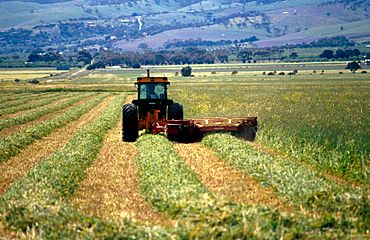Aldinga, South Australia facts for kids
Quick facts for kids AldingaSouth Australia |
|||||||||||||||
|---|---|---|---|---|---|---|---|---|---|---|---|---|---|---|---|

Cutting hay near Aldinga, south of Adelaide in South Australia, 1992
|
|||||||||||||||
| Established | 1857 | ||||||||||||||
| Postcode(s) | 5173 | ||||||||||||||
| LGA(s) | City of Onkaparinga | ||||||||||||||
| Region | Southern Adelaide | ||||||||||||||
| County | Adelaide | ||||||||||||||
| State electorate(s) | Kaurna Mawson |
||||||||||||||
| Federal Division(s) | Mayo | ||||||||||||||
|
|||||||||||||||
|
|||||||||||||||
| Footnotes | Climate Adjoining suburbs |
||||||||||||||
Aldinga is a suburb located in South Australia. It is about 45 kilometers (28 miles) south of the main Adelaide city centre. Aldinga is part of the City of Onkaparinga.
It is a small suburb, with a population of around 573 people in 2016. Aldinga is about one kilometer (0.6 miles) east of the larger suburb of Aldinga Beach. The beachfront is about three kilometers (1.9 miles) away.
History
Aboriginal use of Aldinga
Before European settlers arrived, the Kaurna people lived on the land. Their territory stretched from the Adelaide plains down the western side of the Fleurieu Peninsula. There was a Kaurna camp in Aldinga called Camp Coortandillah.
Kaurna people continued to live in the Aldinga Scrub until the 1870s. After this time, they were moved to a mission at Poonindie. This marked the end of their long connection to the Aldinga area. Later, some Aboriginal people from the Goolwa area, known as Ngarrindjeri people, lived there. The Kaurna language name for Aldinga was Ngaltingga.
European settlement and growth
After British settlers arrived in South Australia, Aldinga began to grow as a town in the 1850s. This happened because farming was developing on the Aldinga Plains. A local farmer named Lewis Fidge is credited with planning the town around 1857.
The town quickly grew. A hotel, a church, a blacksmith's shop, and other stores were built. However, in the 1870s, the land became less productive for farming. Also, new land became available in other parts of South Australia. This caused the town's population to shrink.
Despite this, Aldinga survived. Its location on the Old Coach Road was very important. This road connected Aldinga to towns further south along the coast. Today, this route is part of the Main South Road. The Aldinga Post Office opened around 1851 but closed in 1992.


